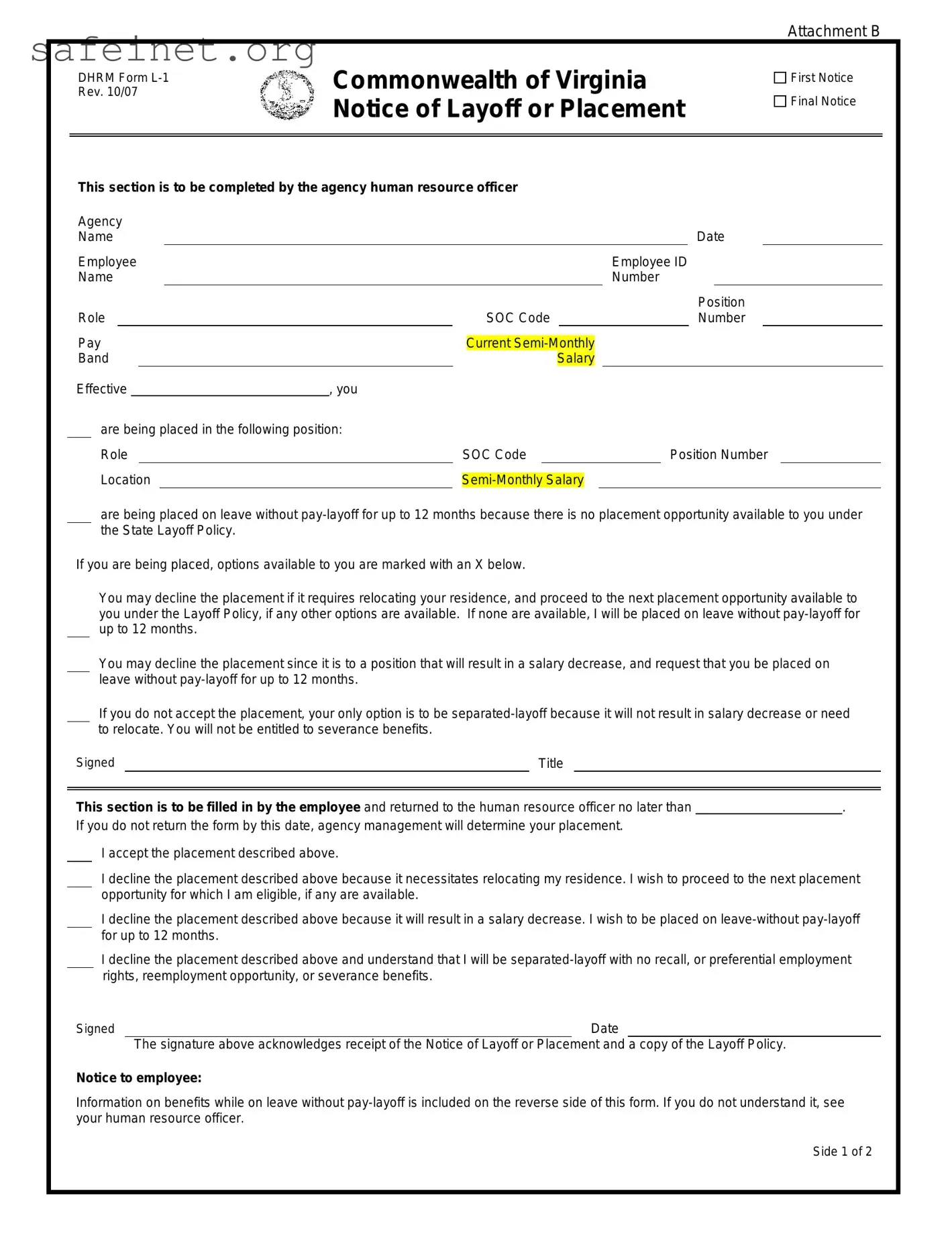Commonwealth of Virginia Notice of Layoff or Placement
This section is to be completed by the agency human resource officer |
|
|
|
|
|
|
|
Agency |
|
|
|
|
|
|
|
|
|
|
|
|
|
|
|
|
|
|
Name |
|
|
|
|
|
|
|
|
|
|
|
|
|
Date |
|
Employee |
|
|
|
|
|
|
|
|
|
|
|
Employee ID |
Name |
|
|
|
|
|
|
|
|
|
|
|
Number |
|
|
|
|
|
|
|
|
|
|
|
|
|
|
|
|
|
|
|
|
|
Position |
Role |
|
|
|
|
|
SOC Code |
|
|
|
Number |
|
Pay |
|
|
|
|
|
|
|
|
|
|
|
|
|
|
|
|
|
|
|
|
|
|
Current Semi-Monthly |
|
|
|
|
|
|
|
Band |
|
|
|
|
|
|
|
Salary |
|
|
|
|
|
|
|
|
|
Effective |
|
|
, you |
|
|
|
|
|
|
|
|
are being placed in the following position: |
|
|
|
|
|
|
|
|
Role |
|
|
|
|
SOC Code |
|
|
Position Number |
|
|
|
Location |
|
|
|
|
|
|
|
|
|
|
|
|
|
|
|
|
|
|
|
|
|
|
Semi-Monthly Salary |
|
|
|
|
|
|
|
are being placed on leave without pay-layoff for up to 12 months because there is no placement opportunity available to you under the State Layoff Policy.
If you are being placed, options available to you are marked with an X below.
You may decline the placement if it requires relocating your residence, and proceed to the next placement opportunity available to you under the Layoff Policy, if any other options are available. If none are available, I will be placed on leave without pay-layoff for up to 12 months.
You may decline the placement since it is to a position that will result in a salary decrease, and request that you be placed on leave without pay-layoff for up to 12 months.
If you do not accept the placement, your only option is to be separated-layoff because it will not result in salary decrease or need to relocate. You will not be entitled to severance benefits.
Signed |
|
Title |
|
|
|
|
|
|
This section is to be filled in by the employee and returned to the human resource officer no later than |
. |
If you do not return the form by this date, agency management will determine your placement. |
|
|
I accept the placement described above.
I decline the placement described above because it necessitates relocating my residence. I wish to proceed to the next placement opportunity for which I am eligible, if any are available.
I decline the placement described above because it will result in a salary decrease. I wish to be placed on leave-without pay-layoff for up to 12 months.
I decline the placement described above and understand that I will be separated-layoff with no recall, or preferential employment rights, reemployment opportunity, or severance benefits.
Signed |
|
Date |
|
The signature above acknowledges receipt of the Notice of Layoff or Placement and a copy of the Layoff Policy. |
Notice to employee:
Information on benefits while on leave without pay-layoff is included on the reverse side of this form. If you do not understand it, see your human resource officer.
Side 1 of 2
Recall, Preferential Employment, and Re-employment Opportunity Rights
Recall is the placement of an employee who is on leave without pay-layoff status, demoted in lieu of layoff, or who accepted a position that resulted in a reduction in salary, into a position that is in the employee's pre-layoff Role, salary and agency.
•If you have been placed in a position in your same Role or Pay Band that does not require a salary reduction or relocation, you will have no recall or preferential employment rights. You may apply for openings as otherwise provided by agency policy and the State Hiring Policy.
•If you have been demoted in lieu of layoff, accepted a position that resulted in a reduction in salary, or have been placed on leave without pay-layoff, you will be eligible for recall for up to 12 consecutive months from the effective date of the transaction.
•If you decline recall to your former Role and salary in your former agency, your name will be removed from the recall list, unless the recall was declined because acceptance of the position offered would require residence relocation or reduction in salary.
Preferential Employment is the right of an employee on leave without pay-layoff to obtain a vacant position in other Executive Branch agencies in his/her formerly held Role without competing with candidates outside the hiring agency.
If you are being placed on leave without pay-layoff, you will be eligible for preferential employment and be selected for the position if the following criteria are met:
1.the advertised position is the same Role and Role code as your formerly held position (Role and Role codes are indicated on your preferential hiring card);
2.the agency does not select an applicant who is currently employed within that agency;
3.the agency determines that you are at least minimally qualified for the advertised position;
4.you apply for the position on or before the closing date for receipt of applications;
5.you present an application and your preferential hiring card (DHRM Form L-2) that was issued to you upon layoff; and
6.twelve consecutive months have not passed since the effective date of your leave without pay-layoff.
If you accept a position in another agency in the same Role or in a higher pay band your recall rights will cease, and you must notify the human resource officer of your former agency. Preferential employment does not prohibit you from applying for any externally advertised vacancy and being considered for the position in accordance with the State Hiring Policy.
Re-employment Opportunity is the voluntary program in which employees who choose to participate have their work credentials entered into a computerized database (re-employment opportunity pool) that can be used by Executive Branch agencies in recruiting applicants for vacancies. Employees interested in participating in the pool should complete a Re-employment Opportunity Application form immediately prior to their placement on leave without pay-layoff status.
Severance Benefits
When you are placed on leave without pay-layoff and eligible to receive severance benefits, you may maintain the State's benefits for up to 12 months. However, if you resign, or decline a recall to your former Role that does not involve relocation or salary reduction, your benefits will cease.
Medical Insurance
The State’s contribution toward employee and family medical insurance will continue for the period of leave without pay-layoff (LWOP-layoff) unless you decline recall to your former Role or voluntarily resign before the end of leave without pay-layoff. You will be responsible for the employee’s portion of the health insurance premium. If you wish to change your insurance coverage, you should contact your agency's Benefits Administrator.
Group Life Insurance
The State's contribution toward your group life insurance will continue for the period of LWOP-layoff.
Other Payroll-Deducted Programs
If you participate in other programs (cancer, Deferred Compensation Plan, etc.) through payroll deductions, contact your payroll office to find out how to continue membership in such programs during the time you are on LWOP-layoff.
Retirement
No refund of contributions can be made to you while you are on LWOP-layoff. If you wish to withdraw your VRS contributions, you can do so only by resigning from state service and forfeiting your right of recall and preferential employment.
Severance Pay-out
Eligible full-time employees are entitled to transitional severance benefits when placed on LWOP-layoff based on their number of years of continuous service. Payments cease if reemployed by the State.
Leave Balances
You will be paid at the beginning of your LWOP-layoff for any overtime and compensatory leave balances which you were eligible to accumulate. You may elect to be paid for your annual leave and sick leave (as eligible) at the beginning of your LWOP-layoff or you may leave such balances to your credit for the period of such leave. If you are not paid for these balances, they will be paid upon your separation, per policy. Disability credits are paid only at separation.
Service Credit
You will not be eligible to accrue leave while you are on LWOP-layoff. Time spent on LWOP, up to a maximum of 12 months, will count as active service in determining your annual leave accrual rate, months of service for VSDP, and whether you qualify for payment of 25% of your “traditional” sick leave or disability credit balance on termination. Time spent on LWOP-layoff does not count toward the 12 months probationary period.
The effective date of your eligibility for performance increases upon recall, or upon placement in another agency, will be established by the Performance Planning and Evaluation Policy.
Unemployment Compensation
If you are placed on LWOP-layoff, you should visit the local office of the Virginia Employment Commission to determine your eligibility for unemployment compensation benefits.
Side 2 of 2


 First Notice
First Notice 
 Final Notice
Final Notice